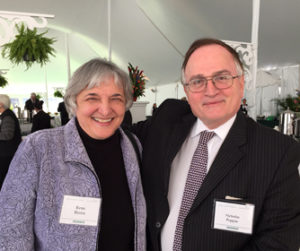Biomedical Engineer Dr. Rena Bizios of UTSA Elected to National Academy of Medicine
 By Christi Fish, Executive Director of University Communications, UTSA
By Christi Fish, Executive Director of University Communications, UTSA
From The University of Texas at San Antonio:
UTSA faculty member, educator and researcher Rena Bizios, a pioneer in biomedical engineering, has been elected to the National Academy of Medicine, one of the highest honors for medical sciences, health care and public health professionals. Bizios’ election to the National Academies moves UTSA one step closer to Tier One, a designation that includes, among other things, the number of faculty at a university with memberships in the National Academies.
Bizios is the first tenure-track UTSA faculty member to be elected to the National Academies and the third overall.
The research interests of Bizios, a Peter T. Flawn Professor in the UTSA Department of Biomedical Engineering, include cellular and tissue engineering, tissue regeneration, biomaterials (including nanostructured biomaterials) and biocompatibility. She is recognized for making seminal contributions to the understanding of cell-material interactions, protein/cell interactions with nanostructured biomaterials, and for identifying the effects of pressure and electric current on cell functions during new tissue formation. Her research has applications in the tissue engineering and tissue regeneration fields.
“When I started in this field, biomedical engineering was not well-known or well-understood,” said Bizios. “I didn’t know if it would be successful or not. I took a risk.”
While Bizios takes great pride in the achievements of the undergraduate and graduate students she has mentored, her work extends well beyond her own classroom and laboratory. She has taught fundamental undergraduate and graduate engineering courses and developed new biomedical engineering courses. Moreover, she has co-authored a landmark undergraduate textbook, An Introduction to Tissue-Biomaterial Interactions. The textbook is a standard in the biomaterials field and has been adopted for upper-class undergraduate and beginning graduate courses by several biomedical engineering programs in the United States and abroad.
“Rena Bizios is a wonderful example of the tremendous faculty that top-tier universities are known for,” said UTSA President Ricardo Romo. “Through her teaching, research and mentoring at UTSA, Dr. Bizios has made significant contributions that have shaped, and will continue to shape, biomedical engineering. I am so pleased to see her work recognized by her peers in the National Academies.”
Bizios’ career includes long-standing service to engineering at the departmental, university, regional, national and international levels. She has served on numerous committees and held elected officer positions in several societies including the Biomedical Engineering Society, Society for Biomaterials, American Institute of Chemical Engineers, and American Institute for Medical and Biological Engineering. She frequently speaks at universities around the world, and at national and international conferences.
Professor Bizios’ peers also have recognized her research accomplishments and contributions to education. She has received several awards including the Rensselaer Alumni Association Teaching Award (1997); Clemson Award for Outstanding Contributions to the Literature, from the Society for Biomaterials (1998); Distinguished Scientist Award, from the Houston Society for Engineering in Medicine and Biology (2009); 2010 Women’s Initiatives Mentorship Excellence Award, from the American Institute of Chemical Engineers; Founders Award, from the Society for Biomaterials (2014); Theo C. Pilkington Outstanding Educator Award, from the Biomedical Engineering Division of the American Society for Engineering Education (2014); and Amber Award, from the UTSA Ambassadors (2014). She was also elected a charter member of the UTSA Academy of Distinguished Researchers earlier this year.
Moreover, Bizios is a fellow of five professional societies: the American Institute for Medical and Biological Engineering, International Union of the Societies for Biomaterials Sciences and Engineering, Society of Biomedical Engineering, American Institute of Chemical Engineers, and American Association for the Advancement of Science.
“Our newly elected members represent the brightest, most influential, and passionate people in health, science, and medicine in our nation and internationally,” said National Academy of Medicine President Victor Dzau. “They are at the top of their fields and are committed to service. The expertise they bring to the organization will help us respond to today’s most pressing health-related challenges and inform the future of health, science, and medicine.”
UTSA College of Engineering Dean JoAnn Browning added, “We are proud to have such an outstanding professional like Dr. Rena Bizios teaching and conducting research here at UTSA. Not only has Dr. Bizios made many significant contributions to her field, she is also an outstanding mentor to our students in the biomedical engineering program and is so deserving of this honor.”
“I am delighted and I feel humbled by this honored inclusion by my peers,” said Bizios. “I share it with all of my students, past and present, and with my colleagues who have collaborated with me.”
The National Academy of Medicine is an independent organization of eminent professionals from the fields of health and medicine as well as the natural, social and behavioral sciences. Founded in the 1970, the NAM administers fellowships, scholarships and awards in addition to hosting workshops, expert meetings, symposia and other initiatives to respond to current and emerging needs in health and medicine.
This year, the National Academy of Medicine will induct 70 new members and 10 international members, raising its total active membership to 1,826 and its number of international members to 137.
—————————–
Learn more about the UTSA Department of Biomedical Engineering.

